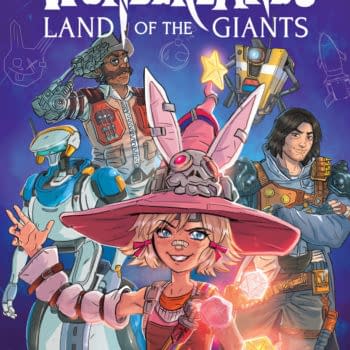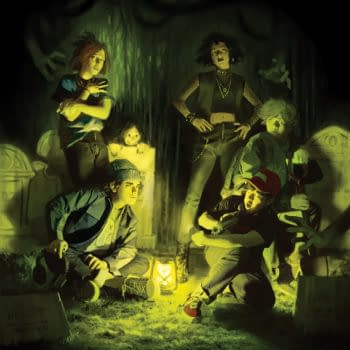Posted in: Comics, Recent Updates | Tagged: Comics, image, jennifer de guzman, saga
Retailers Respond To Image's Decision To Drop Second Prints

So I asked a number of retailers for their thoughts.
Dan Wallace of Impulse Creations, Tulsa, OK
My only reaction is that I have never ordered with any thought given to the likelihood of a 2nd print. I always simply order what I believe we can sell.
Occasionally, I under order and a new printing comes in handy. More often though, I just feel obligated to order 1-2 copies of a new print for the few customers who will want it because they want all versions of the title and I'd prefer to not deal with a separate line item just for that.
All in all, this policy change really means nothing to us. We'll probably be caught short now and then but that's just as likely to happen on books that wouldn't have been reprinted any way.
However, I would not be surprised if at least part of the reason for this is that Image would rather have customers looking for a sold out book buy a digital copy instead of investing in a new printing. That way, they save the cost of going back to press and also get a chance to convert those customers to buying all their books digitally.
That's pure speculation of course but it's worth considering given other publisher efforts in the digital market of late.
Tom of Effin Comics
I don't care at all for the following statement: "First, it means that retailers under-ordered it." Not one bit.
Retailers order based on previous performance of a book. If the latest issue of any comic outperforms previous issues, that is a reason to celebrate, not a reason to criticize your distribution network of retailers. I suppose that her point, though, is that a sell out likely means that there was a greater need in the marketplace for the item than expected. If Image really believed that we under ordered, then they should over printed even more to account for anticipated demand. If they cannot have that level of faith in their own product, who can they expect us to.
Their print run is based on our orders. Our orders are based on our customers' pre-orders and our perception of what we can sell. It is not an exact science. Our orders are un-returnable, after all, so we have to always order cautiously but sensibly. I can't trust a publisher telling me to order more; I can only trust my analysis of the needs of my particular store.
For someone who works in public relations, Ms. de Guzman should learn to watch her words. You don't chastise your retail network or your customers.
Also, if you want an indy-type book to survive, you have to make it accessible. If the first print run sells out, there is a need. Fill it with a second print run. Otherwise, you create the perception that you, as publisher, do not care about the customers'/consumers' need.
My quick and simple response is that it's time for publishers to understand what a publisher's job is and what a retailer's job is.
Retailers don't under order to any greater extent than publishers underprint. A quality publisher ensures there is product to meet demand and unless this particular publisher is stating that retailers who know they can sell X copies are purposefully ordering X-2 for their shelves, blaming retailers for under ordering, is just plain silly.
Hey, if the publishers don't have enough confidence in their books to order enough copies to have in stock long term, why would retailers? We did our job. We sold every copy the publisher made, with no guarantees. If the publisher had made more, we might have sold those too but it is not our job to maximize a publishers sales, that is their job. Ours is to maximize our sell through.
And in the case of Saga, seeing that it was 4 months since issue 6, it might have been wise for the publisher to beef up orders, since there would be a dearth of Saga sales on retailers cycle sheets for the previous 3 months and may have artifically decreased orders for #7.
Rich of Whatever Comics
My 2 cents – It's a bad idea. Being on hiatus for 3 months, let alone one month, kills momentum for a book. Customers who were hooked came in month after month, then came in to find out it's running late. For them things come up, other books come out (Image alone releases dozens of new titles monthly) and irregular regulars cannot remember dates, unless you were to stamp it on their foreheads which we can't do. So they stop asking after a few weeks and maybe even forget about it. Then the trade came out. Great for us. A selling point for our store is, here is the collection AND you can get caught up and start reading it monthly, because oh look, here is the next issue, #7. They buy both. So retailers now are selling even more #7 than issue #6, I know we did. So when we do sell out of #7, especially with #8 coming next week, where will that leave us? Once again potential customers are going to be lost because we can't order more of #7. Now they have to wait more months to get the second trade because they can't get #7 when #8 is released. How is that helping us? The blame is not on the retailers when we sell out.
"What's even worse news is that orders for SAGA #8 decreased 4% from orders on #7. It will not be reprinted either. We have decided to cease second printings of single issues of titles that are known over-performers in hopes that it will help initial sales find their proper level. That's marketing-speak for "You know this sells, so you'd better make sure you order enough!""
So because some retailers lowered orders, you threaten everyone? The ones on the front line that push and push the book? Lot's of things sell well in our store especially when they run on time. Help initial sales find a proper level – The fact that us retailers are ordering more means its selling well, not because we didn't order enough. I pay my rent and bills by selling and especially suggestive selling, Saga is going to be one of our biggest sellers for us this holiday.
"This isn't meant as a punishment or some weird scheme to drive up prices of single issues on eBay. The weeks of delay in waiting for the second printing cost you sales. Knowing you can count on reprintings has encouraged caution when none is called for, and that hurts you as much as it does us."
This may also drive down sales on future issues if they can't get an issue later on because a retailer has sold out and can't order any more. This potential customer will just wait for the trade if they remember or go online and buy it digitally. The excuse of wasted sales waiting for the second print is untrue. The wasted sale is when they can't get that issue even in a second printing. It doesn't just hurt the stores, it hurts Image's monthly issue orders. I have never relied on a second printing for lower initials. Instead I rely on a second printing when my staff and I are doing their jobs promoting books and we sell out. One more thing. We ordered Saga #1 Image Firsts to promote the book this holiday and the day we get them in, we get an e-mail telling us no more second printings. So even if those customers buy the #1 for a buck, then get the trade and love the book (which they will) they can't get current because there will be no #7's available. And I just did a Image Firsts display.
Sad that Image is pulling a move like this. I was just saying today, while processing this week's shipment, how good it is that Image, for a small company, manages to put out quality books with real covers and more pages than the big 2 for $2.99 (unlike Marvel who has the money behind them and yet still charges way too much for eh comics and sub par crappy nonexistent covers). That's why we like supporting Image. Then I read this e-mail. A clear threat from Image – either order more or too bad so sad. Wow.
Brian Hibbs of Comix Experience writes;
The problem with unincentivized no-reprint policies is that they effectively cap the sales of a book, and leave you no room for growth.
It's a generally bad idea to have to tell customers who just bought trade #1, and come rushing back for more "sorry, sold out of the next issue, now you have to wait 7 months until trade #2 comes out", not JUST because you're minimizing momentum at the point of highest interest in any given cycle, but also because you're then unconsciously signalling to the consumer that they shouldn't buy the serialization at all.
Arc-driven monthly periodicals sell in a wave pattern if a retailer is paying attention — the first chapter of each arc will be your sales high point, then each later chapter sells a little less. THAT'S ABSOLUTELY NORMAL, and that reflects how the actual consumer actually buys in the actual real world.
But each new arc gives you a fresh entry point, and when a book is WORKING, each new wave should be a little stronger than the last.
That SAGA #7 sold out just under a month from release in the wake of the first collection is something to be embraced, and to be strongly followed up on — that means there's more demand than the market anticipated, and that means (ESPECIALLY with it being Chapter-#1-of-the-first-issue-of-the-next-arc-after-a-paperback), you want to ensure that you fill that demand.
I'm actually amazingly confident that there will be a second print of SAGA #7 because it is exactly the kind of book, at exactly the right place in its sales cycle where you want the pipes to be as wide open as possible — the first trade paperback of SAGA will almost certainly be my #1 graphic novel of the year, where I'm still selling a copy a day right now. I need to have copies of #7 in stock straight through the release date of TP v2. At current velocity, I'll be out before the first week of January, which will simply cap sales at that point.
Finally, while I think "absolutely no 2nd printings" is a silly proposal, the real problem is that it is effectively retroactive in the manner in which Image decided to announce it. If I had *known* "exactly one chance to get it right for a six month window, order now!", I certainly would have ordered differently. If a book *won't* be reprinted, then that HAS to be noted at solicitation for the market to make the appropriate decision.
Regan Clem of Clems Comics writes;
"I have some bad news: SAGA #7 is sold out. Sounds like good news, right? Well, it's not. First, it means that retailers under-ordered it."
Could just as easily have read…
I have some bad news: SAGA #7 is sold out. Sounds like good news, right? Well, it's not. First, it means that retailers under-ordered it and we under-printed it.
We both missed the mark. That's the only way a sell out happens.
They knew the orders that came in. If those orders were lower than they expected to sell, they could have printed more. We ordered based upon sales of the previous arc, as I assume all retailers did. Others may have taken lateness into consideration and decreased orders a small percentage. By the way, we still have issues in both of our stores. Only one copy left at one though.
The main person they hurt by not going to second prints is the creators making these books. We have other books to sell, so we really aren't being punished. Image has other books to sell, so they aren't being punished. But the creators onlyhave this book to sell; he and she are being punished.
This is a new arc. To transfer people who experienced the story for the first time through the graphic novel into monthly buyers, the book has to be available. Some of them will likely be buyers of both the monthly and the trade paperback. Second prints are just fine for those people. And people who buy a book like this will usually become long term readers. Long-term win, win, win for everyone. Not knowing the figures, refusing to go to a second print might possibly be a short-term win for the publisher. Creators lose. Retailers lose. And the former loses a lot more than the latter.
Maybe some retailers will order more because of this decision. I doubt it. I don't know what retailer they talked to who acted like they underordered with the intention of relying on a second printing. It's their choice to make a policy like this. But if I were in their shoes, I would choose to keep books in print until they are collected.
Oh, I forgot about the readers. I guess they don't deserve to read the book because the publisher feels that the retailers made an ordering miscalculation. They also lose. But not as much as the creators because they will just buy a different book to read.
Jeremy Adams of Alliance Comics – Baltimore
Image deciding after solicitation to take their ball and go home means no one gets to play with the ball. This really should have been announced to go into effect with the next issue to FOC. This looks like knee-jerk antics.
I hope this was a decision by Vaughn & Staples. Or they were consulted at the very least. It's their money Image is playing games with.
Brian Jacoby of Secret Headquarters, Tallahassee, Florida writes;
A publisher that refuses to do second printings when there is demand for them is manipulating the market just as much as one who under-prints books just so they CAN do second printings to grab more money from collectors. Both are short-sighted, and ultimately hurt everyone's long-term bottom lines.











